What are the Largest Ethnic Groups in the US Today
| Table of Contents |
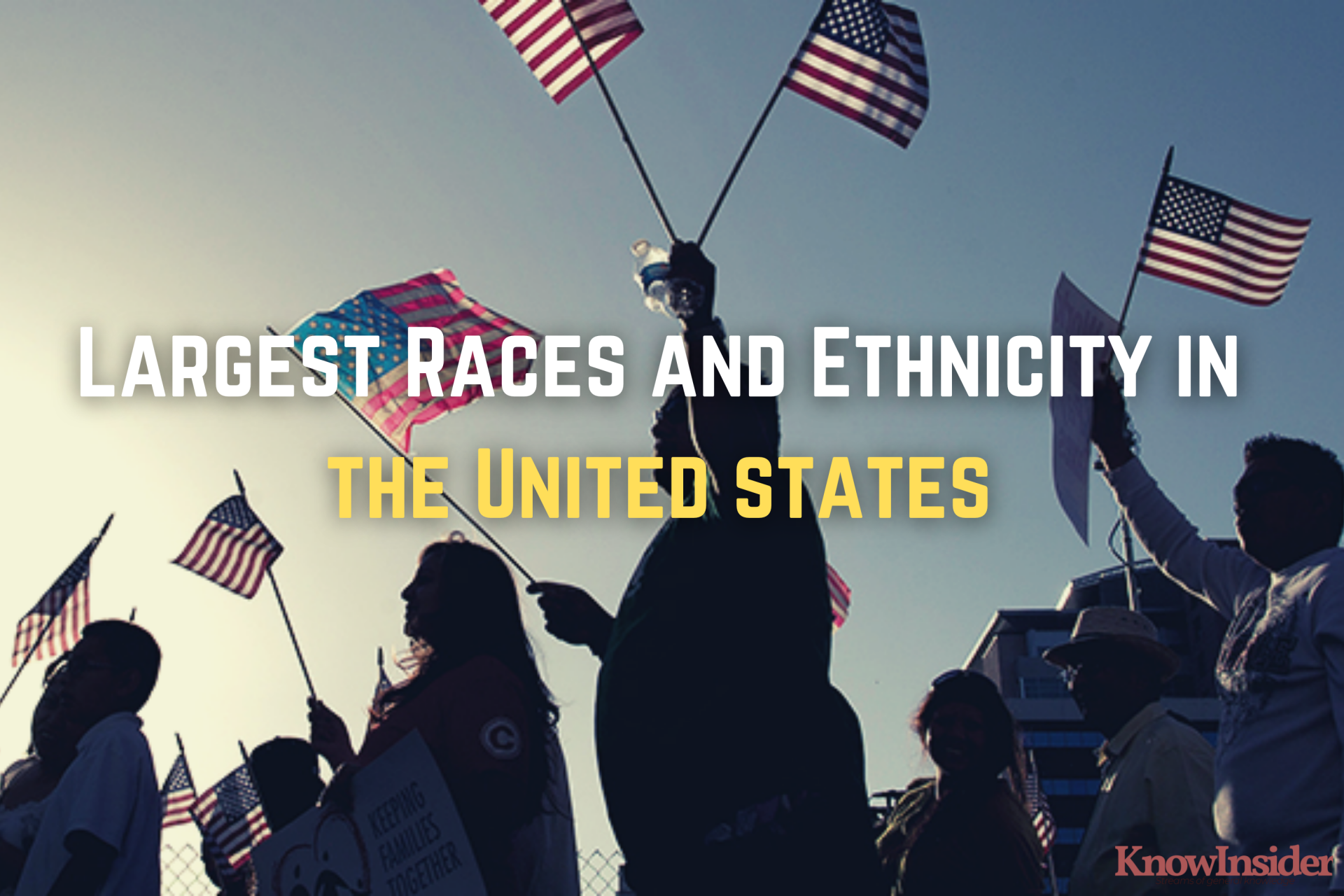 |
| The Largest Ethnic Group & Nationalities in The United States |
Race and Ethnicity in the US
Although the Census Bureau's American Community Survey separately tracks Hispanic and Latino origin, Asian origin, American Indian and Alaska Native tribal groupings, and various other ancestry groups, the 2010 United States Census did not include questions about ancestry in order to avoid controversy. The Census now lists African Americans as a racial group, with ancestry listed only for smaller groups from specific African countries, despite the fact that African Americans were a significant ancestry group in the 2000 Census.
• White: a person descended from any of the ancient populations of North Africa, the Middle East, or Europe. People who report being Afghan, Iranian, Irish, German, Italian, Lebanese, Arab, Moroccan, or Caucasian are included, as are those who identify as "White" people.
• Black or African American: a person who is descended from any of Africa's Black racial groups. It includes those who report being African American, Kenyan, Nigerian, or Haitian, or who identify as "Black, African Am."
• American Indian or Alaska Native: a person who still identifies as belonging to their tribe or feels a strong sense of community despite coming from any of the original peoples of North and South America, including Central America. Those who report entries such as Navajo, Blackfeet, Inupiat, Yup'ik, Central American Indian groups, or South American Indian groups, or who identify as "American Indian or Alaska Native" fall under this category.
• Asian: an individual deriving from any of the original peoples of the Indian subcontinent, the Far East, Southeast Asia, Bangladesh, Cambodia, China, India, Japan, Korea, Malaysia, Pakistan, the Philippine Islands, Taiwan, Thailand, and Vietnam, among others.
• Native Hawaiian or Other Pacific Islander: a person having origins in any of the original peoples of Hawaii, Guam, Samoa, or other Pacific Islands.
• Some other race: comprises all additional responses not covered by the racial categories described above for "White," "Black or African American," "American Indian or Alaska Native," "Asian," and "Native Hawaiian or other Pacific Islander," including Asians from Western Asia or Russia (non-European Russia) and White Africans.
• Two or more races: Individuals have the option to indicate two or more races by either checking two or more boxes related to race responses, giving multiple answers, or using a combination of checkboxes and other responses.
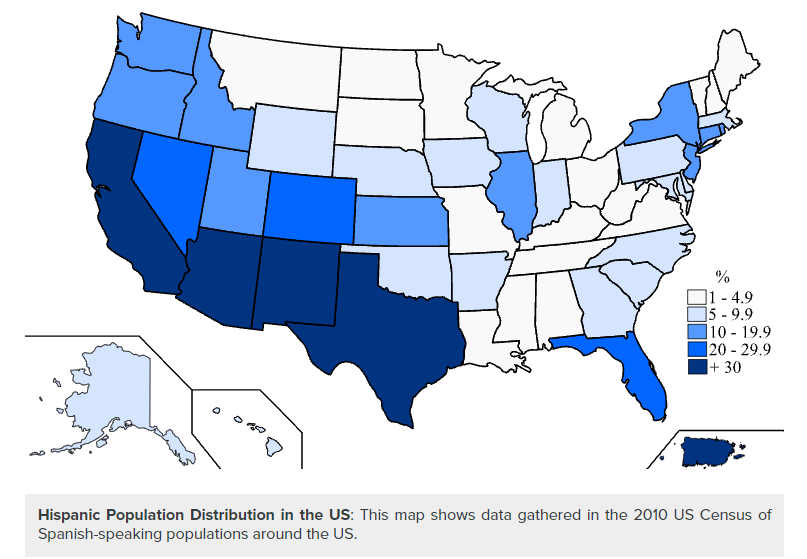 |
Resident Population of the United States by Race from 2000 to 2022 (in Millions)
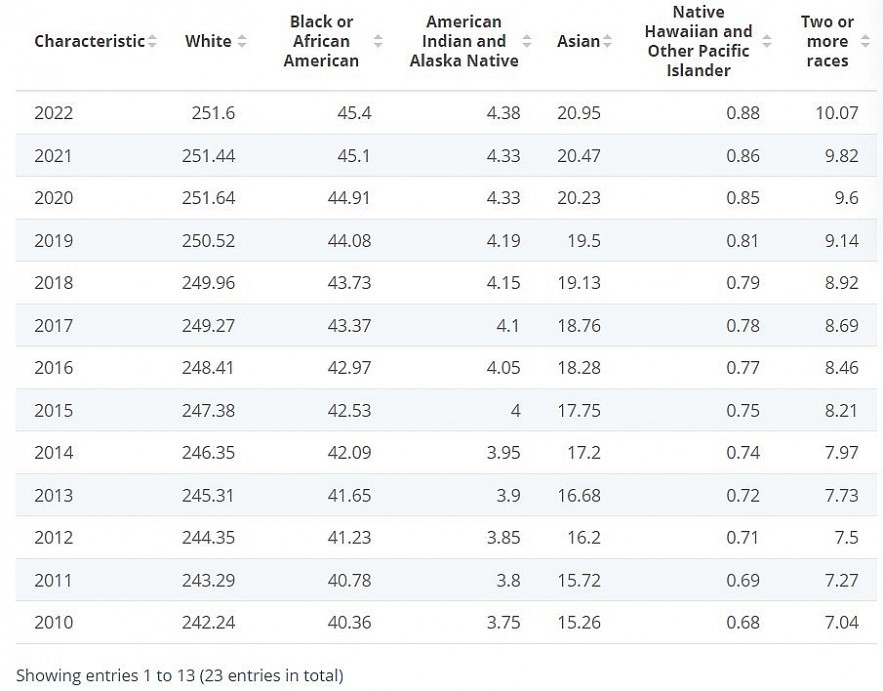 |
| Resident Population of the United States by Race - Source: Statista |
The population of the United States by race and ethnic group is displayed in this graph from 2000 to 2022. There were about 20.95 million Asian Americans residing in the country in 2022.
You can find a list of the languages that people speak most frequently in the world here.
With a projected population of 251.6 million in 2022, white people currently make up the great majority of Americans. In every region, this ethnic group makes up the largest portion of the population, but it is particularly apparent in the Midwest. In the same year, there were 45.4 million Black or African American residents.
From 2022 onward, the total population of the United States is predicted to grow yearly, reaching 341.69 million by 2027 from 320.92 million in 2015. As a result, population densities have also grown, reaching 36.3 people per square kilometer in 2021. The United States is not even among the top 150 most densely populated countries because of its vast land mass, despite being one of the most populous nations in the world, behind China and India. With 26,150.3 people per square kilometer as of 2019, Monaco has the densest population density of any nation in the world.
The Hispanic population in the United States has also experienced a similar trend, rising from 35.7 million in 2000 to approximately 62.65 million in 2021 as the country's population continues to rise. Because of high immigration and birth rates, this population group is one of the main drivers of the nation's population growth. One of the world's most racially diverse nations is the United States.
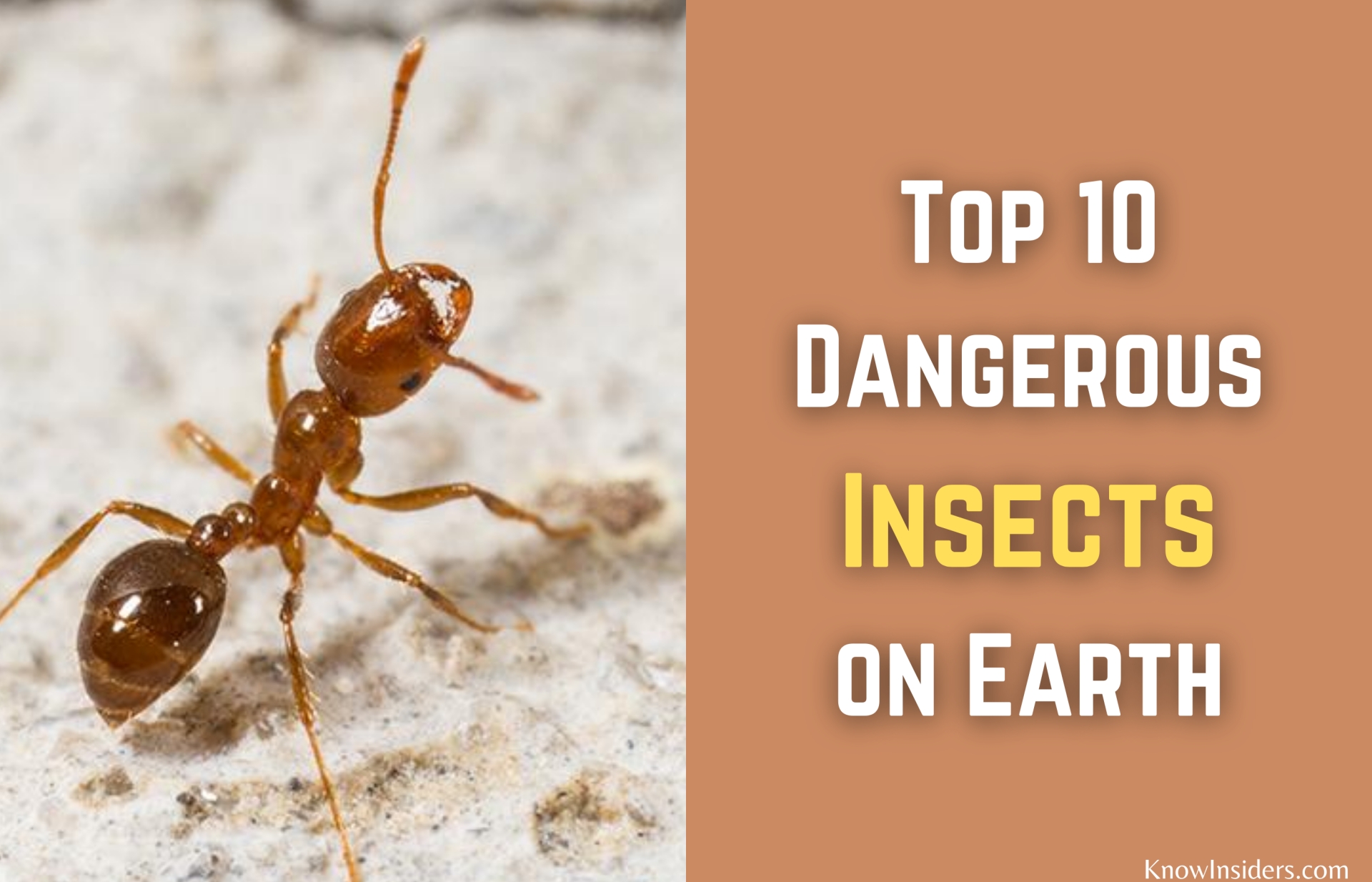 Top 10 Most Dangerous Insects in the World Top 10 Most Dangerous Insects in the World |
Which is the largest ethnic group/nationalities in the US?
As of 2019, here is the current distribution of the U.S. population by race and ethnicity:
#1. White: 60.1% (Non-Hispanic)
#2. Hispanic: 18.5%
#3. Black: 12.2%
#4. Asian: 5.6%
#5. Multiple Races: 2.8%
#6. American Indian/Alaska Native: 0.7%
#7. Native Hawaiian/Other Pacific Islander: 0.2%
From those groups, Americans identity with ethnic groups that are even more specific. More Americans specify as German than any other ethnicity.
African American
Having all or some black ancestry defines a person as black or African-American. Even though the term "African-American" is frequently used, many black Americans claim to have ancestors from other parts of the world, such as the Caribbean and South America. Nonetheless, a large number of people do have African ancestry because European settlers forced a large number of enslaved people to immigrate to North America. These individuals were mostly from West and Central Africa.
Racial prejudice against Black Americans has a long history. Following the Civil Rights Movement's influence, racial discrimination against African Americans was made illegal; however, inequality still persists today. As of right now, 12.3% of people are African Americans.
English
The majority of Americans who claim English ancestry are from the US Northwest. The majority of them were from the British Isles, which comprised Scotland, Wales, and England. As of right now, 12.6% of Americans are of English descent.
Irish
The Great Famine in Ireland caused a large number of people to immigrate to the US in the middle of the 1800s. A sizable portion made their home in the major cities of Chicago, Boston, New York, and Philadelphia. As of right now, the ethnic group accounts for 10.6% of the nation's total population.
Native Americans
1.6% of Americans identify as Native Americans, which includes anyone with ancestry from Alaska and any of the countries in Central, South, or North America. Native Americans were the original inhabitants of the modern-day United States before European colonization. Sadly, the introduction of Europeans brought with them new diseases, many of which have deadly consequences. The number of Native Americans declined, and even now, they continue to experience a disproportionate share of extreme poverty.
Mexicans
Because Mexico is so close to the US, Mexican immigrants have been coming here for as long as the US has existed. The Mexican ethnic group makes up 10.9% of the population and is primarily concentrated in the US southwest. Additionally, 58.5% of the nation's Latino/Hispanic population is Mexican.
Percentage of Races in the United States:
| Rank | Ethnicity | Percentage of Population |
|---|---|---|
| 1 | German | 14.70% |
| 2 | Black or African American (non-Hispanic) | 12.30% |
| 3 | Mexican (of any race) | 10.90% |
| 4 | Irish | 10.60% |
| 5 | English | 7.80% |
| 6 | American | 7.20% |
| 7 | Italian | 5.50% |
| 8 | Polish | 3.00% |
| 9 | French | 2.60% |
| 10 | Scottish | 1.70% |
| 11 | Native American and Alaska Native | 1.60% |
| 12 | Puerto Rican | 1.60% |
| 13 | Norwegian | 1.40% |
| 14 | Dutch | 1.40% |
| 15 | Swedish | 1.20% |
| 16 | Chinese | 1.20% |
| 17 | Asian Indian | 1.00% |
| 18 | Scotch-Irish | 1.00% |
| 19 | Russian | 0.90% |
| 20 | West Indian (non-Hispanic) | 0.90% |
| 21 | Filipino | 0.90% |
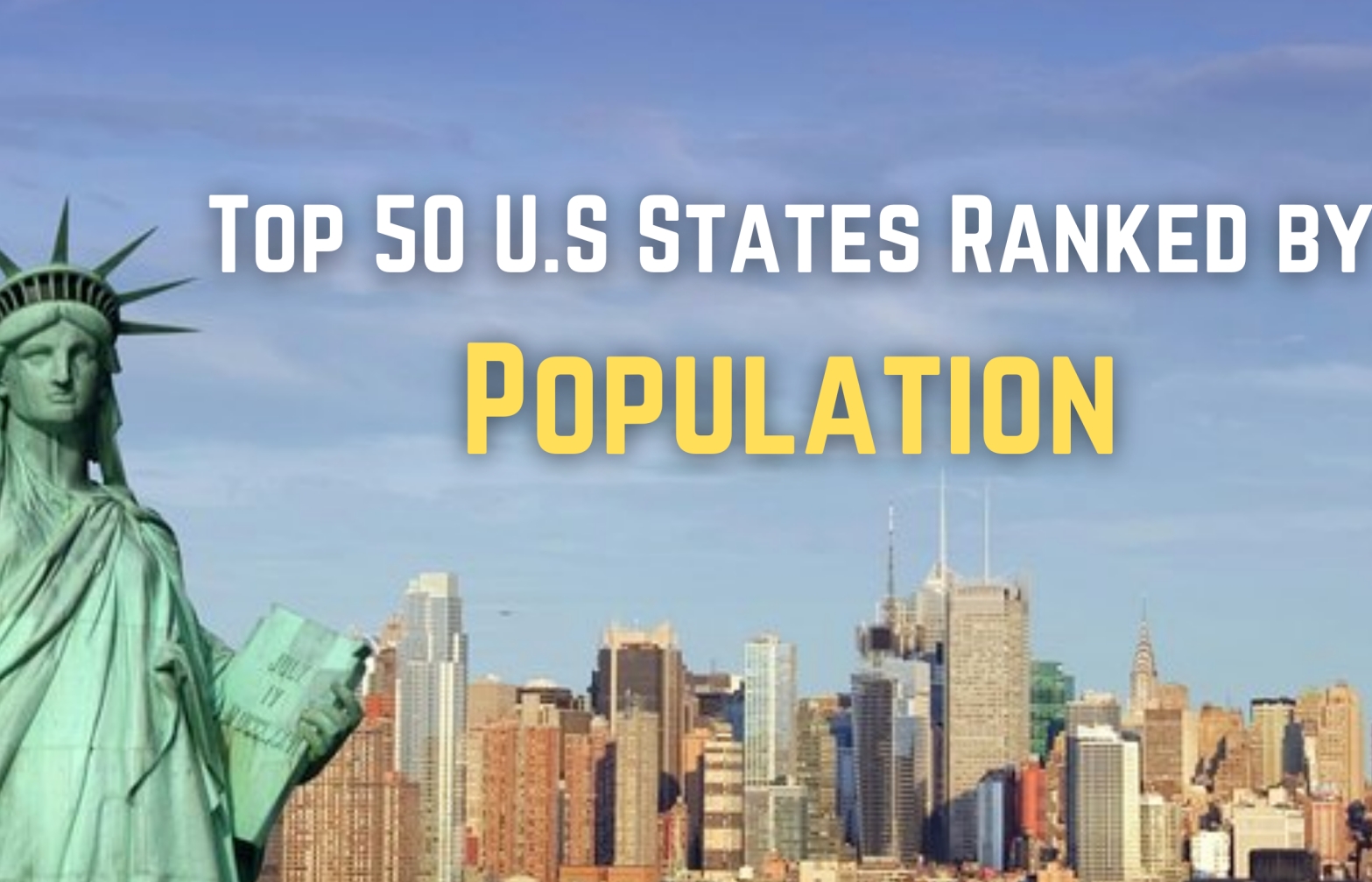 The 50 US States Ranked by Popuplation Today - The Largest and Smallest The 50 US States Ranked by Popuplation Today - The Largest and Smallest With 50 states and other dependent areas, United States (US) has quite a big population in the world: 333,387,218 up to now. Here are the ... |
 Top 10 Largest Hotels in the US Today Top 10 Largest Hotels in the US Today A good hotel makes your vacation great. Let check out the top 10 largest hotels in the US below! |
 Top 10 Oldest Hotels in the US - The First Hotels Top 10 Oldest Hotels in the US - The First Hotels Time stands still in these places in the U.S. Let find out top 10 oldest hotels - the first hotels in America here, which was ... |


























